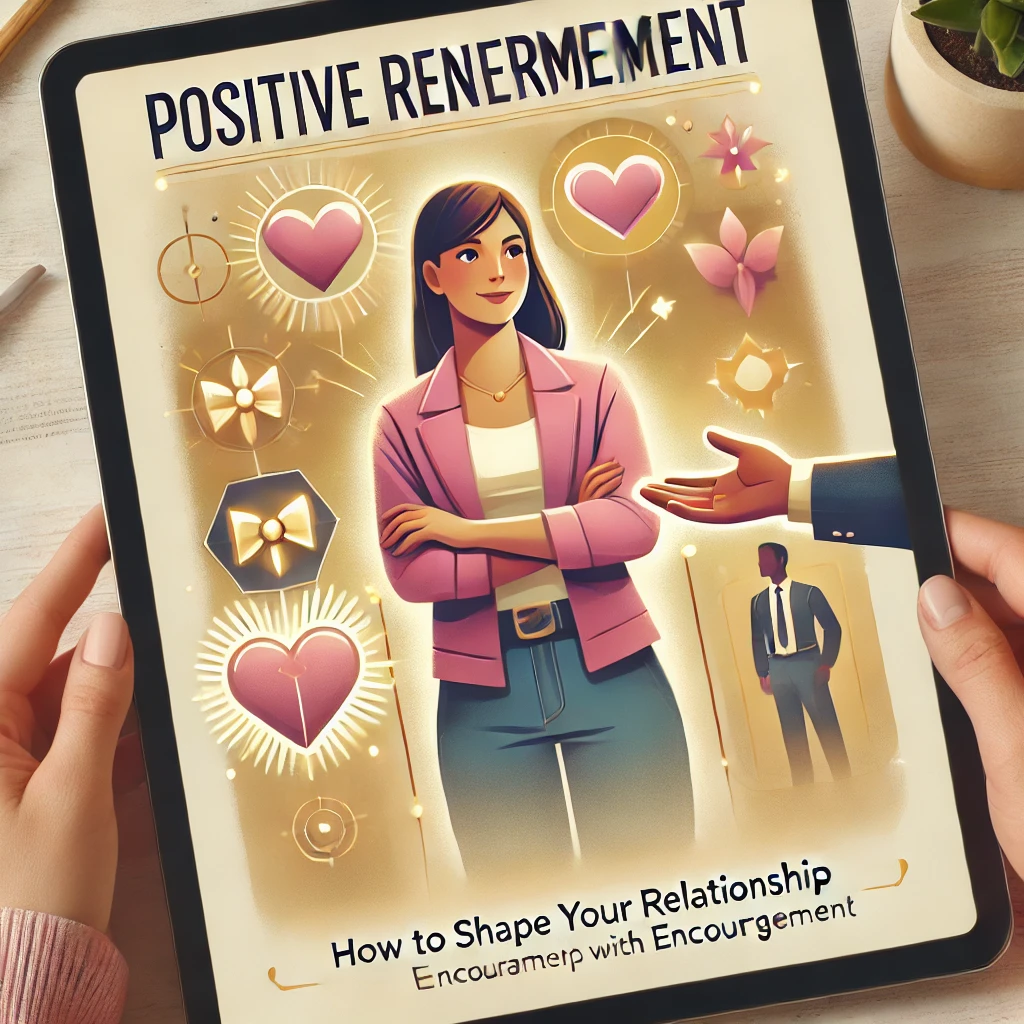In any relationship, whether romantic, familial, or professional, there’s one technique that stands out as both simple and profoundly effective: Positive Reinforcement. This method involves rewarding behaviors that you want to see more of, creating a positive cycle that encourages those behaviors to become more frequent. It’s not about manipulation or control—it’s about nurturing a relationship in a way that reinforces the best behaviors and traits of your partner.
Positive reinforcement is a concept rooted in behavioral psychology, and it can transform your relationship dynamics. When done right, it strengthens your bond, builds trust, and promotes a healthier, happier relationship. The best part? Your partner feels good about it because they’re being encouraged, not coerced.
In this blog, we’ll dive deep into Positive Reinforcement, how it works in relationships, and provide practical, relatable examples that you can use to shape your partner’s behavior. By the end of this, you’ll see why positive reinforcement is a game-changer in relationships—and how you can use it to create a more harmonious and loving connection.
What Is Positive Reinforcement?
Positive Reinforcement is a method where you reward or praise desired behaviors, making it more likely that those behaviors will be repeated. It works because people are naturally inclined to seek approval and positivity. When someone feels good after doing something, they’re more likely to do it again. In relationships, this means you can subtly guide your partner toward behaviors that benefit both of you by simply encouraging and reinforcing them when they do something you like.
Positive reinforcement is effective because it focuses on the good—on rewarding the behaviors you want to see, rather than criticizing the ones you don’t. Over time, this positive cycle creates a more constructive, supportive environment where both partners feel appreciated and motivated to keep doing what works.
Why Does Positive Reinforcement Work in Relationships?
The reason positive reinforcement is so powerful in relationships is that it builds a sense of mutual appreciation and respect. When you consistently reinforce behaviors that make you feel good, your partner starts associating those behaviors with feelings of reward, love, and appreciation. It encourages them to continue doing the things that make the relationship work while avoiding the need for negative confrontation.
In contrast, criticism or nagging—focusing on what’s wrong or lacking—tends to create defensiveness, resentment, and distance. Positive reinforcement does the opposite. It creates a nurturing, encouraging dynamic where your partner feels valued for their efforts, making them more inclined to keep doing things that make you both happy.
How to Use Positive Reinforcement in Relationships
Let’s look at some practical examples of how you can use positive reinforcement to encourage the behaviors and habits you want to see in your relationship.
Example 1: Reinforcing More Quality Time Together
You’ve been wanting to spend more quality time with your partner, but instead of asking directly, you can use positive reinforcement when they make the effort on their own.
How to Use Positive Reinforcement:
The next time your partner suggests spending time together or makes a plan for a date night, shower them with praise and appreciation. “I love when you plan things for us to do—it makes me feel so special and loved when we spend time together.” By reinforcing this behavior with positivity, you’re letting them know that their efforts are not only noticed but cherished.
Why It Works:
Positive reinforcement links their action (planning time together) with positive feelings and praise from you. They’ll feel good about their decision and will naturally want to do it more often because they know it brings you happiness.
Example 2: Encouraging Help with Chores
If you’re feeling overwhelmed by household tasks and want your partner to help out more, positive reinforcement is a great way to get them on board—without nagging or arguments.
How to Use Positive Reinforcement:
Whenever your partner helps out with the chores, no matter how small the task, make sure to acknowledge and appreciate it. “Thank you so much for taking care of the dishes! It really makes my day easier when we share the load like this.” By reinforcing their behavior with gratitude and appreciation, you’re encouraging them to keep it up.
Why It Works:
No one likes to feel like they’re being told what to do. But when their actions are met with genuine appreciation, they’re more likely to keep helping out because it feels good to be acknowledged for their efforts.
Example 3: Reinforcing Healthy Habits
Let’s say you want to encourage your partner to adopt healthier habits, like exercising more or eating better. Rather than criticizing them for their current choices, use positive reinforcement to highlight their progress.
How to Use Positive Reinforcement:
If your partner starts making healthier choices, even small ones, celebrate them! “I’m really proud of how you’ve been making time for your workouts lately. It’s inspiring to see how committed you are to taking care of yourself.” This type of praise reinforces their efforts and encourages them to keep going.
Why It Works:
Positive reinforcement focuses on what they’re doing right, rather than what they need to change. By celebrating their small victories, you’re motivating them to continue with their healthy habits because they feel supported and encouraged by you.
Example 4: Supporting Emotional Vulnerability
One of the most important aspects of a healthy relationship is emotional openness. If you want your partner to be more emotionally available, positive reinforcement can help create a safe space for them to open up.
How to Use Positive Reinforcement:
The next time your partner shares something personal or opens up emotionally, make sure to respond with empathy and appreciation. “I really appreciate you sharing that with me. It makes me feel so close to you when we talk like this.” By reinforcing their vulnerability with warmth and understanding, you’re creating an environment where they feel safe to express their feelings.
Why It Works:
When emotional openness is met with appreciation and validation, your partner will feel more comfortable being vulnerable in the future. Positive reinforcement in this area helps build deeper emotional connections because they know their feelings will be received with care.
Example 5: Encouraging Initiative and Leadership
If you’ve been hoping your partner will take more initiative, whether in planning activities or making decisions, positive reinforcement can guide them toward being more proactive.
How to Use Positive Reinforcement:
When your partner takes the lead on something—whether it’s deciding on dinner plans or initiating a weekend getaway—acknowledge their effort. “I love that you planned this for us! It makes me feel so taken care of when you take the lead like this.” This shows them that their initiative is appreciated and valued.
Why It Works:
Positive reinforcement encourages your partner to continue being proactive because they associate their actions with making you happy. They’ll feel more confident in taking the lead knowing that their efforts are positively received.
Why Positive Reinforcement Is Better Than Criticism
Positive reinforcement is more effective than criticism because it fosters cooperation, trust, and mutual respect. When you focus on what your partner is doing well, you create an atmosphere where they feel appreciated, which naturally motivates them to continue those behaviors. On the other hand, criticism or negative reinforcement tends to create defensiveness and can erode trust over time.
Think about it: no one enjoys being criticized or nagged. It puts people on edge and makes them less likely to want to change. But when you use positive reinforcement, you’re encouraging change through kindness and gratitude, not through guilt or pressure. This makes your partner more willing to engage in behaviors that benefit the relationship because they feel supported and valued.
Tips for Using Positive Reinforcement in Your Relationship
Here are a few key tips for making positive reinforcement work effectively in your relationship:
- Be Genuine: Make sure your praise and appreciation are sincere. People can tell when compliments aren’t genuine, and false praise can backfire. Celebrate their real efforts and contributions.
- Focus on Specific Actions: Rather than giving vague compliments, focus on specific behaviors that you want to reinforce. For example, instead of saying, “You’re great,” say, “I love how you always make time to talk to me about my day. It means a lot to me.”
- Reinforce Consistently: Positive reinforcement works best when it’s consistent. Make sure to acknowledge and appreciate positive behaviors regularly to encourage a lasting change.
- Pair Praise with Positive Outcomes: When possible, link your praise to a positive outcome. For example, “I really appreciate you taking the lead on this—it made the whole weekend more enjoyable for both of us.”
Q&A:
- What is positive reinforcement in relationships, and how does it work?
Positive reinforcement in relationships involves encouraging behaviors you want to see more of by praising or rewarding them. This approach helps reinforce positive actions, making your partner more likely to repeat them. It’s about creating a positive cycle that benefits both partners, without resorting to control or criticism. - How can positive reinforcement improve communication in a relationship?
Positive reinforcement encourages open communication by rewarding honesty and vulnerability. When your partner shares their feelings or takes time to talk openly, expressing appreciation can make them feel valued, which fosters more open conversations in the future. - What are some examples of positive reinforcement in romantic relationships?
- Example 1: If your partner plans a date, express gratitude and admiration: “I love that you planned this. It means so much to me.”
- Example 2: When they do something thoughtful, like helping with chores, show appreciation: “Thank you for doing this; it makes my day easier!”
These affirmations encourage them to repeat such actions because they feel valued.
- Why is positive reinforcement more effective than criticism in relationships?
Criticism often leads to defensiveness and can erode trust over time, while positive reinforcement builds trust, appreciation, and cooperation. When people feel valued, they’re more motivated to continue behaviors that contribute positively to the relationship. - How can I use positive reinforcement to encourage my partner to help with chores?
When your partner takes the initiative on a household task, acknowledge it with specific praise: “I really appreciate how you took care of the dishes. It makes everything feel more manageable.” This recognition reinforces that their help is noticed and valued, making them more likely to repeat the behavior. - What are the benefits of using positive reinforcement in a relationship?
Positive reinforcement builds trust, strengthens bonds, and encourages constructive habits without negative feelings. It creates an environment of mutual respect and gratitude, helping both partners feel appreciated for their efforts and more motivated to contribute to the relationship. - How can positive reinforcement help in resolving conflicts with my partner?
During conflicts, focusing on what your partner does right instead of what’s wrong can help de-escalate the situation. If they listen or show empathy, express appreciation: “I appreciate you listening to me; it means a lot.” Reinforcing positive actions during tense moments makes it easier to resolve conflicts constructively. - What are some common mistakes people make with positive reinforcement in relationships?
- Overuse: Constant praise without sincerity can seem insincere.
- Vagueness: Being too vague, like saying “You’re great,” doesn’t reinforce specific actions.
- Ignoring Negative Behaviors: Only focusing on positive behaviors without addressing serious issues can create imbalance. Use positive reinforcement thoughtfully and sincerely for the best results.
- Can positive reinforcement be used to support emotional vulnerability in a relationship?
Absolutely. When your partner opens up emotionally, respond with empathy and gratitude: “Thank you for sharing that; it makes me feel closer to you.” Positive reinforcement creates a safe space for emotional vulnerability, encouraging your partner to be more open in the future. - How do I start using positive reinforcement to build a healthier relationship?
Start by observing the actions you appreciate in your partner and express specific gratitude for them. Be genuine, focus on specific actions, and reinforce consistently. Over time, this approach can shape a relationship dynamic filled with mutual respect, trust, and happiness.
Ready to Master Positive Reinforcement in Your Relationship?
If you’re ready to take your relationship to the next level, “Mastering Him: The Secret Art of Gentle Control in Relationships” is your ultimate guide. In Chapter 5, you’ll dive deeper into Positive Reinforcement and discover 12 other powerful techniques to help you shape your relationship with love, kindness, and encouragement.
Get your copy today and start mastering the art of influence in your relationship. It’s time to build a connection where both partners feel valued, supported, and motivated to bring out the best in each other.
Read more about the book: https://developmentpill.com/mastering-him-the-secret-art-of-gentle-control-in-relationships-a-guide-to-influence-hell-never-see-coming/
Book Link: https://www.amazon.com/dp/B0DKKGLZQ9
Book Link UK: https://www.amazon.co.uk/dp/B0DKKGLZQ9
You can find book Links for other regions in this post page: https://developmentpill.com/mastering-him-the-secret-art-of-gentle-control-in-relationships-a-guide-to-influence-hell-never-see-coming/



